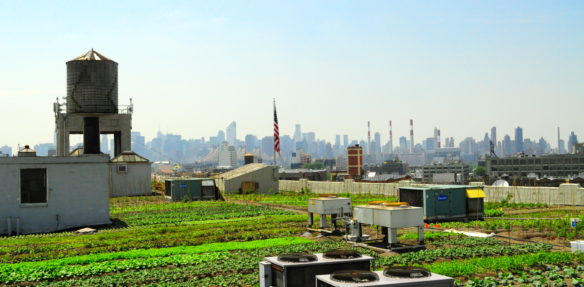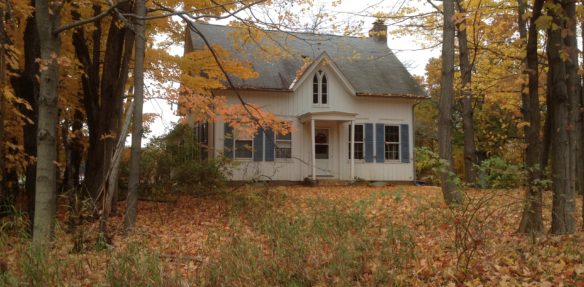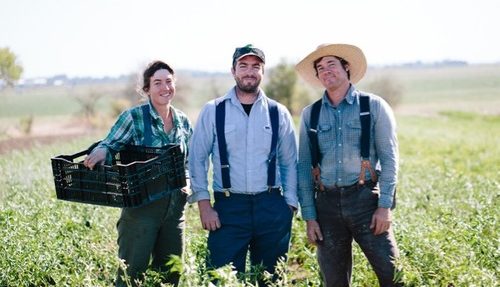
“There are all these rooftop spaces that are unused and land is expensive. If you are able to utilize a rooftop, there are environmental benefits to that but there is also the fact that you can utilize all this unused space.”
– John Stoddard
Backstory
Rooftop farms can turn unused urban space into productive growing spaces. They can provide fresh food to the local community as well as environmental benefits like absorbing rainwater and preventing stormwater runoff, providing habitat for insects and birds, and cooling air temperatures (black roofs make cities hotter than rural areas by absorbing heat during the day and radiating it out at night, while rooftop farms lower the temperature of roofs and surrounding air). Higher Ground is an urban rooftop farm in Boston, Massachusetts, currently owned and operated by John Stoddard.
John’s interest in starting Higher Ground was inspired by his concern for various environmental justice issues. As an environmental studies major at the University of Vermont, he was particularly interested in the impact of toxic agricultural chemicals on public health. To explore this interest, John enrolled at Tufts University to pursue a master’s degree in Agriculture, Food, and the Environment.
Upon graduation from Tufts, John and his then-business partner, Courtney Hennessey, started thinking about starting their own farm operation. Specifically, they began looking into the different ways people were farming in urban areas. In the course of their research, they toured a rooftop farm also featured in this toolkit, Brooklyn Grange, which piqued their interest in the model. In addition to potential environmental benefits, rooftop farming is practical. “There are all these rooftop spaces that are unused and land is expensive. If you are able to utilize a rooftop, there are environmental benefits to that but there is also the fact that you can utilize all this unused space. Whereas, if we were to lease a piece of land, it would be unaffordable,” John explains.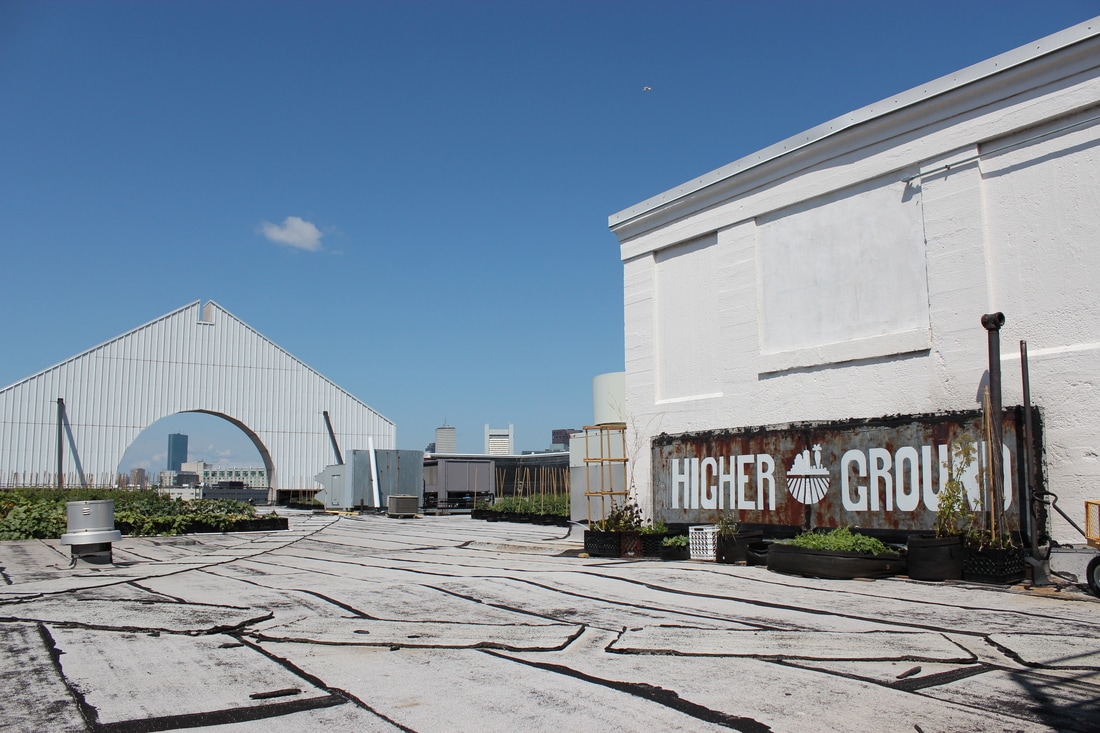
Accordingly, John and Courtney began their search for a roof. In terms of parameters, the roof needed to be at least 20,000 square feet so they could grow enough produce to be profitable and achieve economies of scale. With these requirements in mind, they biked around Boston, visiting neighborhoods where they knew there were large commercial buildings. They “Google-earthed” buildings to survey rooftop landscapes. They connected with developers. They also looked at nearby cities, like Cambridge. They looked at about 10 roofs in total, but none of them were the right fit. (On one occasion, they found a roof they liked but the owner decided to lease it to a solar company instead.)
After about a year and a half of looking, John and Courtney found what is now the Higher Ground rooftop farm. In fact, they were in the neighborhood looking at a different building that day. When that roof didn’t work out, John remembered that there was another large building in the area. “There was a sign about leasing, so we called,” John explains. When they went to look at the building, they discovered it met their requirements and eventually chose it as the rooftop for Higher Ground.
The entire roof is four acres and John and Courtney lease about 1.3 acres (approximately 56,000 square feet). The rest of the roof is used for solar power.
Ensuring Structural Soundness
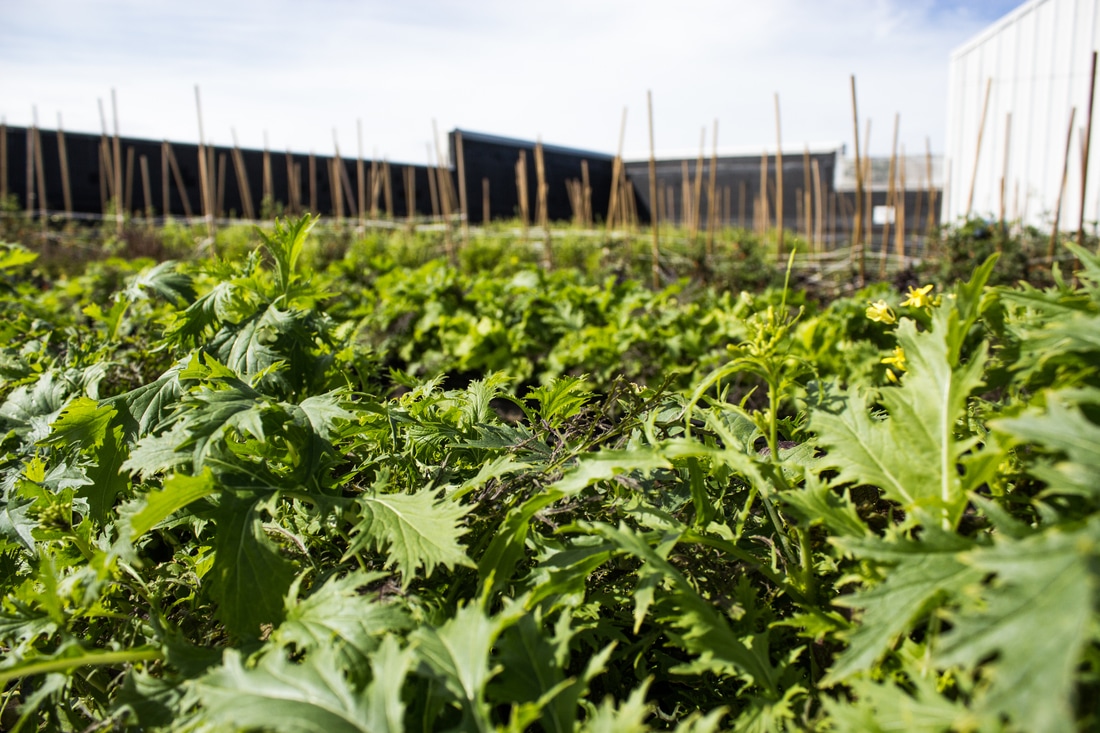 Just as land farmers need to ensure that prospective farming grounds are workable for their particular purposes, rooftop farmers need to ensure that their foundations are structurally sound. Thus, before John and Courtney went forward with raising capital and negotiating a lease, they had to make sure that their target rooftop could actually support farming.
Just as land farmers need to ensure that prospective farming grounds are workable for their particular purposes, rooftop farmers need to ensure that their foundations are structurally sound. Thus, before John and Courtney went forward with raising capital and negotiating a lease, they had to make sure that their target rooftop could actually support farming.
To do this, they had to go through a structural engineering process. “We began by researching the building on our own. We couldn’t find enough information that way because the building was built in the early 1900s and records showing loading capacities were not available,” John explains. So the pair hired a structural engineer to assess the roof for load capacity – “basically how much weight we could safely add to the roof.”
Start Up Costs
Once they established that the roof was sound, they began their search for capital. They needed all of the typical supplies and infrastructure necessary to begin a farming operation such as seeds, soil, irrigation, permits, and plumbing. There were also, however, costs unique to rooftop farming like planters and a crane to get everything onto the roof. John and Courtney decided to get creative to raise the necessary capital.
“We were lucky because it was the beginning of the crowdfunding craze,” says John. Indeed, they financed a large portion of their start up costs through a Kickstarter campaign. John attributes their Kickstarter fundraising success to the enthusiasm of the community. “There were so many people that were excited for this to happen in Boston,” says John. However, although Kickstarter “was great,” John notes, it wasn’t easy. To draw attention to their project, they ran a lengthy promotional campaign, including social media efforts. They also hosted two fundraisers with live music and dinners prepared by local chefs.
Negotiating The Lease & Using An Attorney
Confident in the roof and on their way to securing needed funding, they began to negotiate the lease with the building’s owners. John says he was lucky because his father is a commercial real estate attorney who conducted the negotiation on the farm’s behalf. John explains the benefits:
“It was really helpful [to have an attorney] because I didn’t know the different lease arrangements that you could have."
For example, their lease allows for low rent payments in the first two years. Thereafter, the rent is 10% of the farm’s sales. John explains that other rooftop farms typically pay per square foot. “We are paying substantially less than others and that is because we had a lawyer to help out,” says John. He explains the lease structure will also depend on the landlord and “what they are looking to get out of this. Is it income or is it to be a PR thing and make the building unique and give back to the community? We got the latter kind of landlord.”
Using a lawyer helped Higher Ground secure other favorable provisions in the lease, in addition to low rent. For example, the landlord wanted to give them rooftop access only during specific hours but they were able to negotiate 24-hour access.
However, some lease provisions present challenges. For example, the lease requires significant insurance – $1 million in liability and a $3 million umbrella. The greatest obstacle the lease presents, however, is the lack of public access to the farm. “Our lease specifically limits access of others to the roof. Everyone is really concerned about liability despite the fact that we have millions of dollars in insurance.” Thus, Higher Ground cannot host public events, like farm dinners. “This really inhibits the farming business,” John says. The farm is allowed to utilize volunteers, and they have used this exception as one way to bring members of the public to the farm. Still, “it’s tough,” says John.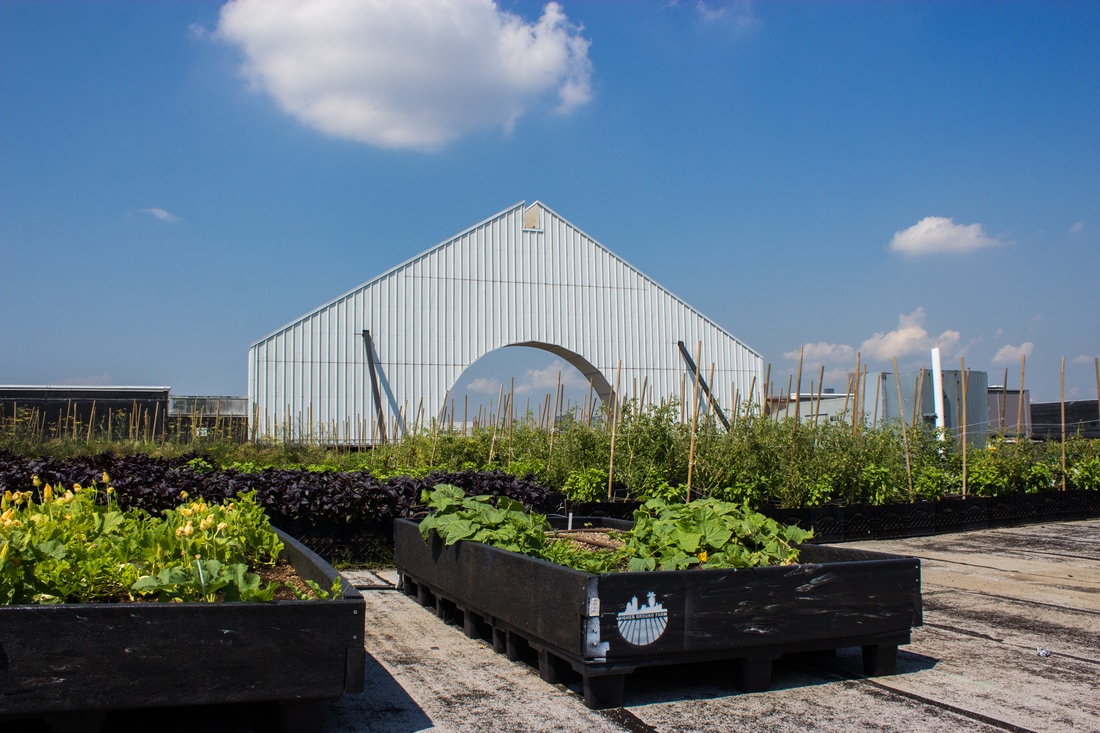
Zoning
Zoning is another concern for would-be urban famers. The Boston zoning process recently changed to better accommodate urban farming by providing a clearer city permitting path for rooftop and other urban farms. John explains that if they were to start a farm now, they would go through the Boston urban farming permit process. However, because Higher Ground was created just before the new zoning regulations were put into place, John applied to the city for a seasonal permit (technically a variance from the old Boston zoning regulations, which didn’t expressly allow for urban farming). For now, in order to comply with zoning regulations, Higher Ground will simply have to continue reapplying to the city of Boston for its seasonal permit.
Finally Farming
In 2013, Higher Ground began its first growing season. The farm sells mostly to restaurants and in its first few years focused on “the regular things” – herbs, greens, and tomatoes. In 2015, Higher Ground diversified to expand its appeal to a broader market. John explains that they wanted to start selling directly to the community. Accordingly, they expanded their produce line-up to include carrots, melon, squash, peas, and beans, and established a farm stand in the building’s lobby. John explains that “it’s tough because there are a lot of local farms and they access the same market. We lucked out because if we didn’t have the restaurant connections, we would have had a difficult start.” Many of those connections came from John and Courtney’s own years of working in restaurants, and the involvement of chefs and the restaurant community from the farm’s beginning allowed it to “hit the ground running.”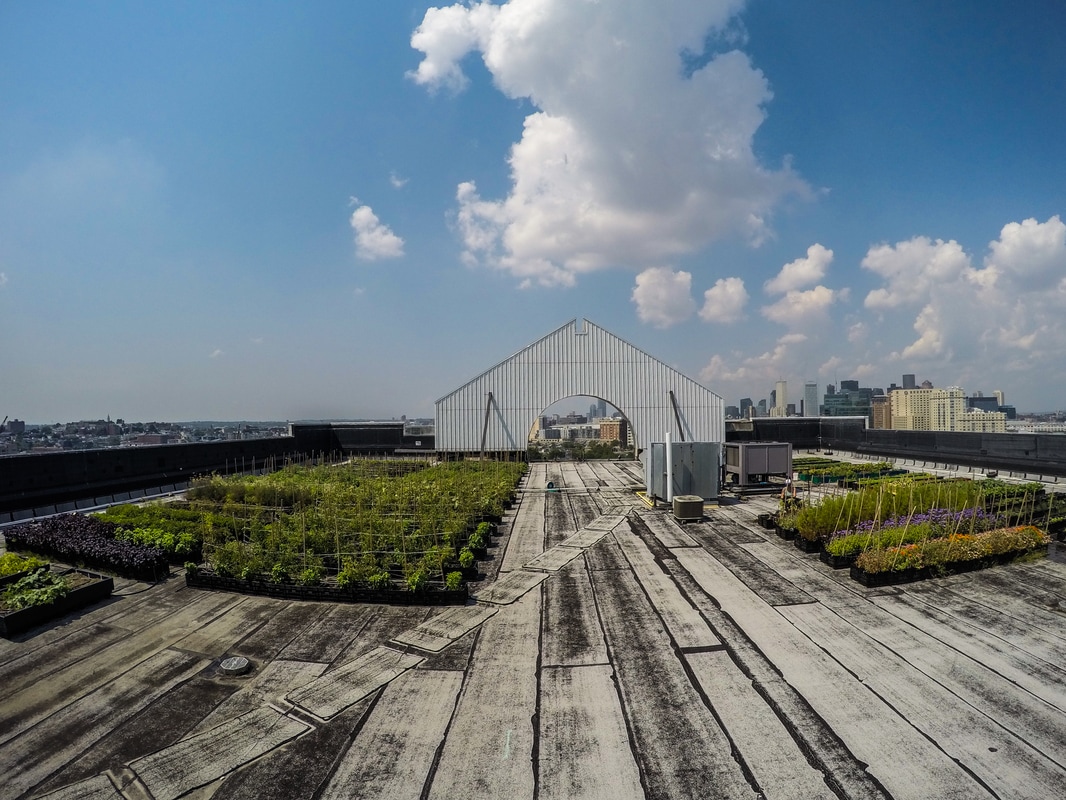
John attributes part of their success to the Boston community. “We knew people in Boston and we cultivated a community of supporters.” Even before the pair had settled on a roof, they had begun networking. “We just started going to things. We met with the city of Boston and told them what we wanted to do. We met with food initiative people. Once we had a website and a Facebook page and people were able to connect with us online, we were able to grow the community and gain support. We didn’t want to let these people down.” John also worked with local restaurant connections, met with the press, and created a social media following.
John also attributes their success to the novelty of their venture. “It’s new and different. We get a ton of attention. And that has its own value – besides an ego boost,” John jokes. “People are very curious about rooftop farms. They want to see it. They want to help work on it. They are excited about green innovation. That has helped us to recruit volunteers and attract press attention, which allows us to make connections and has led to new opportunities. Conceptually, it just has a lot going for it.”
Looking Back
John’s advice for aspiring farm seekers is: “If you believe in something, go for it. It’s hard work but the path will clear. We had a passion and a drive to do this.” It is also important, however, to be realistic. “Working with a financial advisor and being able to make projections and understand your business model is really important.” Another suggestion John has is to “get involved in your community as much as you can. Rely on and support each other.”
As for rooftop farmers, specifically, John says, “It’s an awesome thing to do. For urban farming, you really have challenges in terms of scale. Are you able to get to a scale where your business is profitable?” He also advises that allowing public access to the farm is important because selling produce alone may not generate enough money for the farm to survive. “Public access helps you to access additional revenue streams like hosting events and dinners,” John says. “This is not so different from a rural farm that might host hay bale rides.”

Looking Forward
John’s hope for the future of Higher Ground is that they “find a way for the business to be economically sustainable.” Financing Higher Ground continues to be a challenge. The Kickstarter campaign was strictly a start-up tool and the farm no longer accepts donations. There is room for growth, however. Currently, John only farms approximately a quarter of the land he leases. “A farm the size of ours doesn’t make enough money,” John explains. He feels that they need to expand and explore other business models. “I’m learning as I go,” he says, “and I think [that] while it’s been challenging, it’s been successful… depending on your measure of success. We feel good about what we do.”
